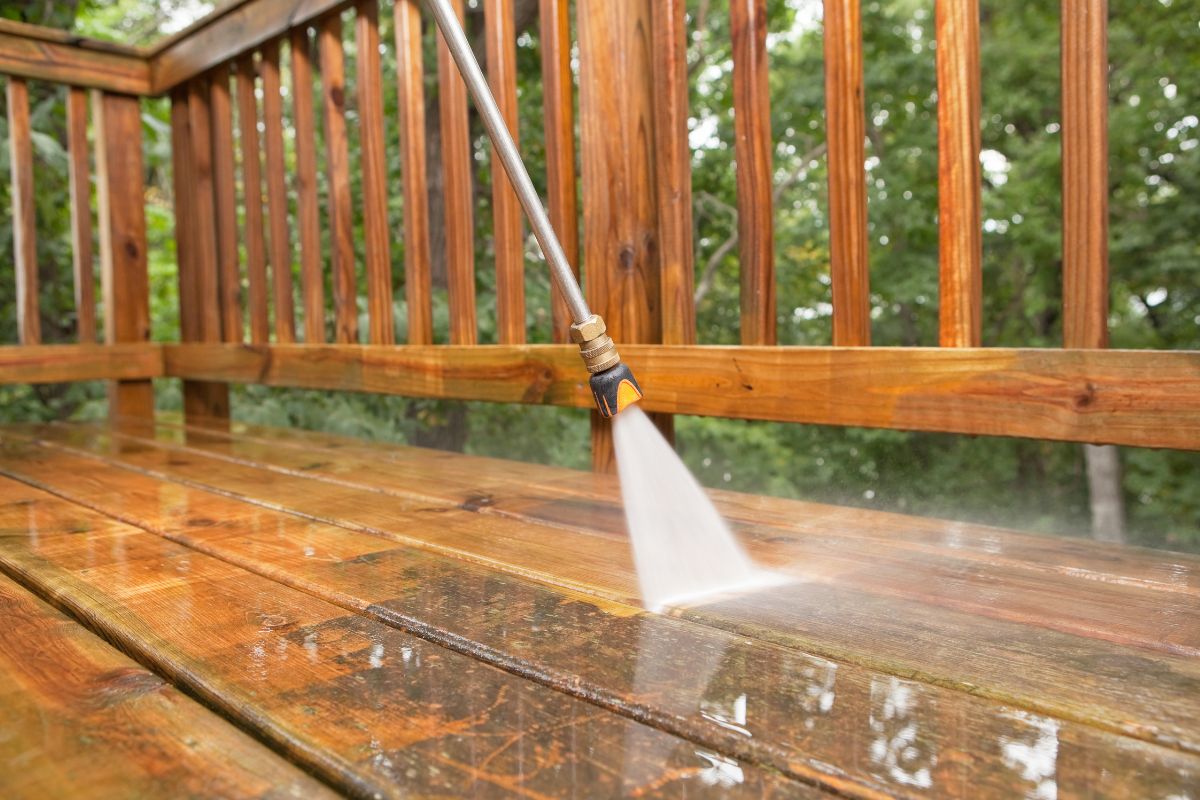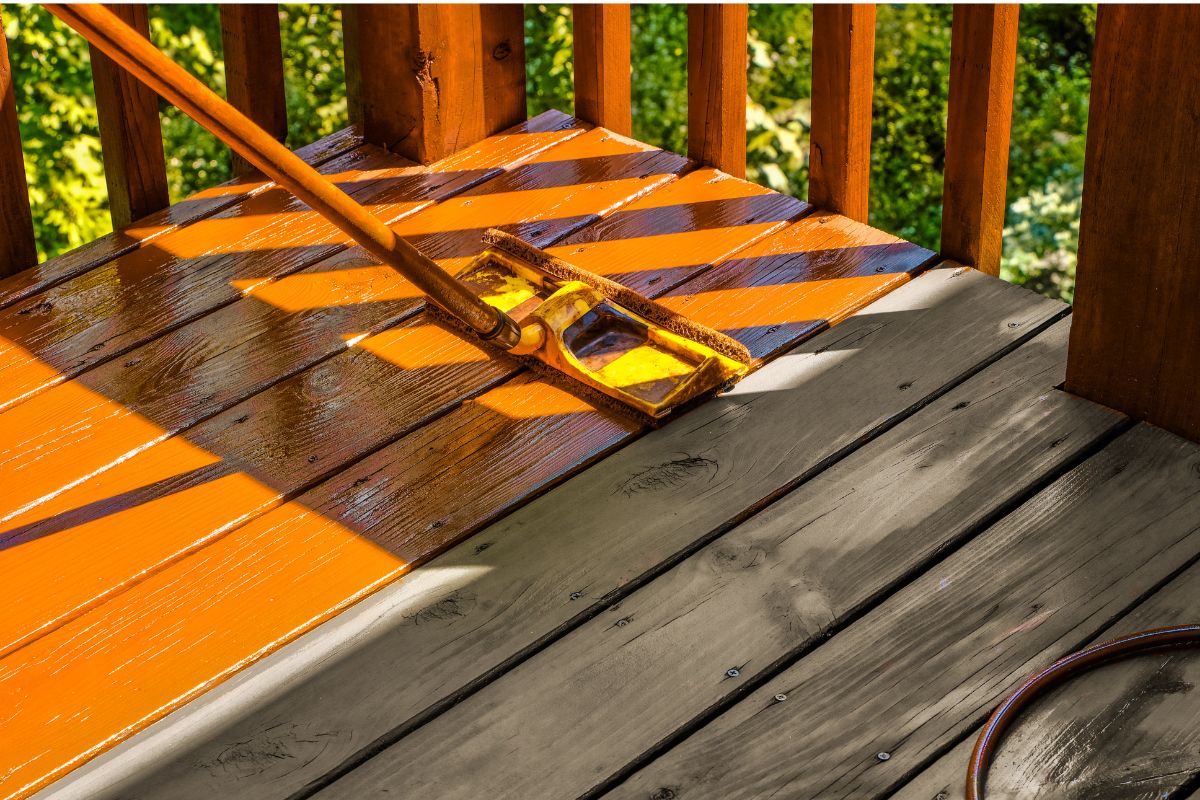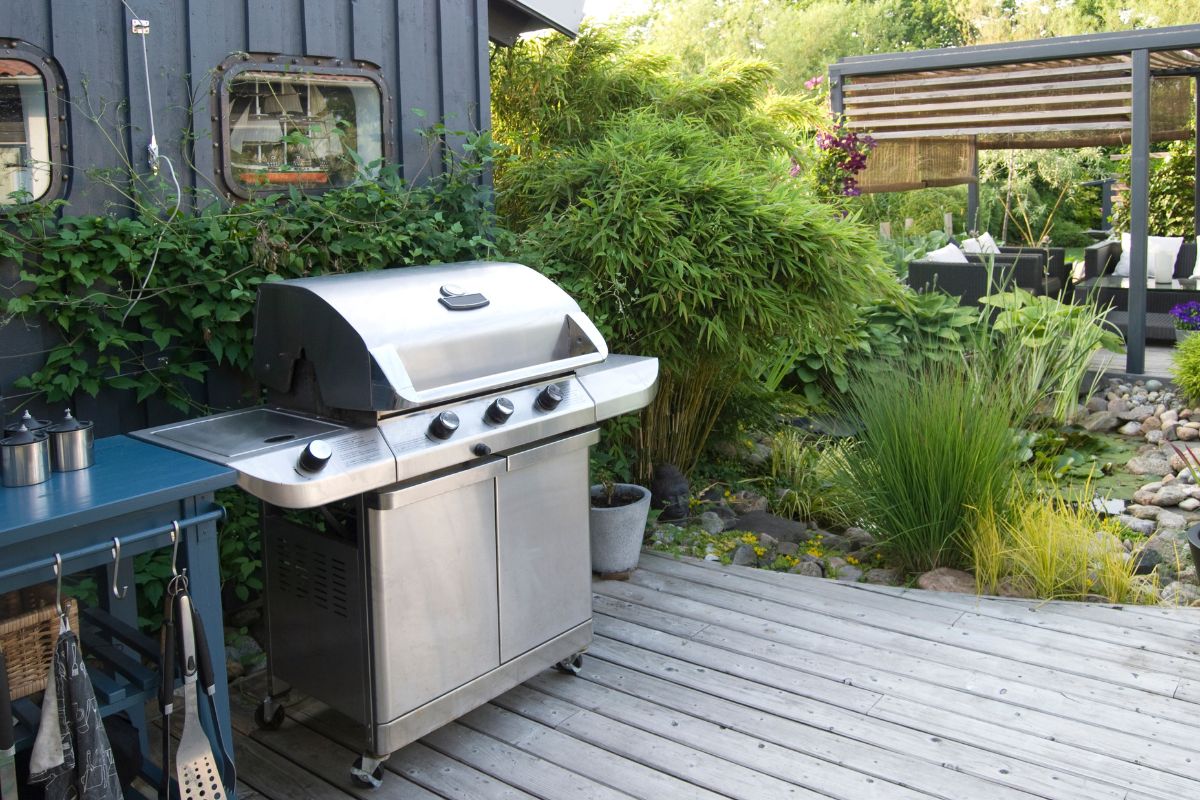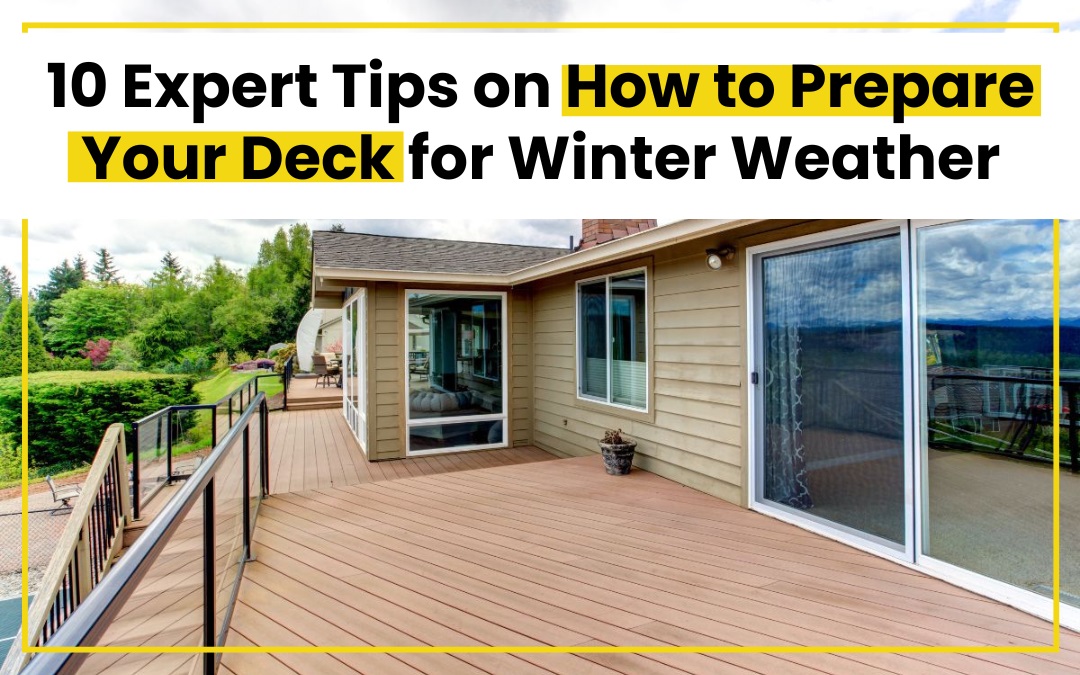As winter creeps in, your deck is at risk of serious damage from snow, ice, and freezing temperatures. If you don’t take steps to protect it, you could be facing expensive repairs by the time spring arrives. Imagine dealing with rotting wood, cracked boards, and rusted fasteners—all because your deck wasn’t ready for winter.
But here’s the good news: with a little effort now, you shield your deck from the harshest elements and make your deck last longer. You’ll also avoid the headaches that come with neglect.
In this article, you’ll discover 10 simple yet effective tips to prepare your deck for winter and keep it in top condition all year long.
Is your deck ready for the cold months ahead? Perimeter Remodeling is here to help you design and build a stunning, weather-resistant deck that will last through winter and beyond. Relax, entertain, and enjoy the outdoors year-round with a deck built to withstand it all.
Start planning your winter-proof deck now!
1. Clean the Deck Thoroughly

A clean deck is the first step in protecting it from the harsh winter months. Dirt, leaves, and other debris can trap moisture, leading to mold, mildew, and even long-term damage like staining or wood rot.
Sweep Off Debris
Start by grabbing a broom and sweeping away any loose debris, like leaves, dirt, and twigs. This step is easy to overlook, but it’s crucial. Letting organic material sit on your deck for too long can trap moisture, which leads to:
- Mold and mildew growth
- Unsightly stains
- Premature wood decay
By removing debris now, you’ll reduce the risk of these problems, especially once the snow starts to fall. Learn more on how to clean a wooden deck.
Power Wash the Surface
After sweeping, it’s time to deep clean your deck with a pressure washer. This helps blast away any grime, algae, or mold that’s stuck to the surface.
Not only does this improve the appearance of your deck, but it also helps prevent slipping hazards when the deck gets wet or icy.
When power washing, be sure to:
- Use a fan tip nozzle to avoid gouging the wood.
- Hold the washer at least 12 inches from the deck surface.
- Work in sections to ensure an even clean.
If you don’t own a power washer, consider renting one or hiring a professional for the job. Either way, a deep clean will make a world of difference in how your deck handles the winter ahead.
2. Inspect for Damage
Before winter truly sets in, it’s crucial to give your deck a thorough inspection. Winter weather can amplify existing problems, leading to costly repairs if not addressed early.
Check for Rot and Cracks
Wooden decks are particularly vulnerable to rot and cracks, especially if they haven’t been properly maintained. Look over your deck boards and other wooden surfaces for signs of:
- Rot: Soft or spongy wood that crumbles easily.
- Cracks: Visible splits or gaps in the wood that could worsen with freezing temperatures.
- Warping: Boards that have bent or twisted out of shape.
If you spot any of these issues, it’s essential to address them before the weather gets worse. Minor repairs now can save you from major problems later.
Tighten Loose Screws or Nails
Winter can cause your deck to expand and contract as temperatures fluctuate. This movement can loosen screws and nails, potentially leading to structural issues or safety hazards. Here’s what you should do:
- Inspect Fasteners: Check all screws, nails, and bolts for looseness.
- Tighten as Needed: Use a screwdriver or drill to secure any loose fasteners.
- Replace Damaged Fasteners: If any fasteners are damaged or corroded, replace them to ensure stability.
By tightening loose screws and nails now, you’ll help prevent shifting and potential damage caused by the cold weather. This simple step is an easy way to ensure your deck remains safe and sturdy throughout the winter.
3. Seal the Deck

Sealing your deck is one of the best ways to protect it from the harsh winter weather. A good sealer acts as a barrier against snow, rain, and ice, helping to prevent moisture from seeping into the wood and causing damage.
Here’s how to make sure your deck is well-protected for the colder months.
Choose the Right Sealant
Selecting the right sealant is key to ensuring your deck gets the protection it needs. Look for a sealant that is:
- Water-Repellent: Keeps moisture from penetrating the wood.
- Weather-Resistant: Stands up to freezing temperatures and fluctuating weather conditions.
There are various types of sealers available, including penetrating sealers and film-forming sealers.
Penetrating sealers soak into the wood and provide deep protection while film-forming sealers create a protective layer on top. Choose the type that best fits your deck’s needs and your local weather conditions.
Apply a Fresh Coat of Sealer
Once you’ve chosen the right sealant, it’s time to apply it. This step is crucial for ensuring your deck is ready to handle winter’s worst. Here’s how to do it:
- Prepare the Deck: Make sure your deck is clean and completely dry before applying the sealer.
- Apply Evenly: Use a brush, roller, or sprayer to apply the sealer evenly across the surface. Focus on areas that get the most wear and tear, like high-traffic spots and exposed sections.
- Follow Manufacturer’s Instructions: Each sealer may have specific application and drying instructions. Be sure to follow these closely for the best results.
Applying a fresh coat of sealer will help protect your deck from winter’s moisture and extend its lifespan. With the right sealant and proper application, your deck will stay in great shape through the cold months and be ready for enjoyment when warmer weather returns.
4. Protect the Deck with a Weatherproof Cover
Shielding your deck from the elements is an excellent way to ensure it stays in good shape throughout the winter.
Use a Tarp or Deck Cover
One of the simplest ways to protect your deck is to use a tarp or a specialized deck cover. This approach offers several benefits:
- Prevents Snow Build-Up: A tarp or cover can keep snow from accumulating on your deck, reducing the risk of moisture damage.
- Reduces Ice Formation: By keeping the deck dry, you minimize the chances of ice forming, which can cause damage and create slipping hazards.
When using a tarp or cover, make sure it’s secured properly so it doesn’t blow away in strong winds. Choose a durable, weather-resistant material that can withstand the winter elements.
Install a Pergola or Awning
For a more permanent solution, consider installing a pergola or awning over your deck. These structures provide year-round protection and offer additional benefits:
- Shields from Rain and Snow: A pergola or awning can keep your deck dry during winter storms, preventing water damage and rot.
- Adds Shade and Style: Besides winter protection, these structures can enhance the look of your outdoor space and offer shade in the summer.
Installing a pergola or awning might be a bigger investment, but it can be worth it for the added protection and style. It’s a great way to ensure your deck stays in top shape through every season.
Protect your deck from winter’s harsh effects by using either a temporary cover or investing in a more permanent solution. Enjoy peace of mind knowing your deck is well cared for.
5. Store Outdoor Furniture Properly

Outdoor furniture can take a beating during the winter months, leading to damage and deterioration if not properly cared for.
Clean and Cover Furniture
Before winter sets in, give your outdoor furniture a thorough cleaning. Here’s how to get it ready for storage:
- Wash and Dry: Clean off any dirt, grime, or stains using appropriate cleaners for each type of material (wood, metal, plastic). Allow the furniture to dry completely before covering or storing it.
- Cover or Store: Use weatherproof covers to protect your furniture if you’re leaving it outside. If possible, move the furniture to a garage, shed, or other sheltered area to keep it safe from the elements.
Proper cleaning and covering will help prevent mold, rust, and other types of damage that can occur from exposure to snow, ice, and rain.
Use Furniture Designed for All Seasons
If storing your furniture isn’t an option, consider investing in pieces designed for year-round use. Weather-resistant furniture offers several advantages:
- Durability: Made from materials like high-density polyethylene (HDPE), teak, or powder-coated metals, these pieces can withstand harsh weather without deteriorating.
- Low Maintenance: All-season furniture typically requires less maintenance, as it’s built to resist moisture, UV rays, and temperature fluctuations.
While weather-resistant furniture might have a higher upfront cost, it’s a smart investment for reducing long-term maintenance and replacement costs.
6. Trim Nearby Trees and Bushes
Keeping the area around your deck well-maintained is an important step in preparing it for winter. Overhanging branches and overgrown bushes can pose risks and lead to additional maintenance challenges.
Prune Overhanging Branches
Trees and shrubs that hang over your deck can cause various issues during winter:
- Falling Branches: Snow and ice can weigh down branches, increasing the risk of them breaking and falling onto your deck.
- Damage to Deck: Falling branches can scratch or dent your deck’s surface, leading to damage that could require costly repairs.
To prevent these problems, prune back any overhanging branches. Aim to:
- Cut Back: Remove branches that are close to or hanging over your deck. This reduces the risk of them falling or causing damage.
- Regular Maintenance: Keep up with pruning throughout the year to prevent branches from growing too close to your deck.
Remove Potential Hazards
Bushes and plants close to your deck can also create problems:
- Moisture Trapping: Overgrown bushes can trap moisture against your deck, leading to mold, mildew, and rot.
- Debris Accumulation: Plants that are too close to the deck can catch and hold leaves and debris, making it harder to keep your deck clean.
Trim back any bushes or plants that are close to your deck. This will:
- Improve Airflow: Better airflow around your deck helps it dry out faster after rain or snow, reducing the risk of damage.
- Reduce Debris: Less foliage near the deck means fewer leaves and other debris collecting on and around your deck.
Trim and manage surrounding plants to keep your deck safe from hazards and simplify winter maintenance. This is just one of the many steps in deck maintenance.
7. Clear and Clean Gutters
Maintaining your gutters is a crucial part of preparing your deck for winter. When gutters are clogged, water can overflow and lead to problems like water damage and ice formation.
Remove Blockages in Gutters
Start by inspecting your gutters for any blockages. Leaves, twigs, and other debris can accumulate and cause water to back up. Here’s what you need to do:
- Clean Out Debris: Use a scoop or small shovel to remove leaves and gunk from the gutters. Make sure to get rid of all the buildup to ensure proper flow.
- Use a Hose: After removing visible debris, flush the gutters with a garden hose to clear out any remaining dirt and check for proper drainage.
Regular cleaning helps prevent water from overflowing and dripping onto your deck, which can lead to:
- Water Damage: Persistent moisture can damage your deck’s wood or finish.
- Ice Dams: Blocked gutters can cause ice dams to form, which can further damage your deck and roof.
Check Downspouts for Proper Drainage
Once the gutters are clean, check your downspouts to make sure they’re directing water away from your deck. Proper drainage is essential for avoiding problems such as:
- Pooling Water: Water that doesn’t drain away from your deck can lead to puddles and potential damage.
- Erosion: Water flowing too close to your deck can cause soil erosion and affect the deck’s foundation.
To ensure proper drainage:
- Inspect Downspouts: Make sure they’re not clogged and are properly connected to the gutters.
- Direct Flow Away: Ensure that water is being channeled away from your deck and home. You can use extensions or splash blocks if needed.
Keeping gutters and downspouts clear prevents water-related issues and helps your deck stay in great shape throughout the winter. Regular maintenance avoids costly repairs and ensures your deck remains protected.
8. Store Grills and Outdoor Equipment

Preparing your outdoor space for winter isn’t just about caring for your deck—it’s also important to protect your outdoor equipment.
Proper storage of items like grills and garden tools helps extend their lifespan and prevents damage from harsh winter weather.
Clean and Store Your Grill
Grills are especially vulnerable to winter weather. If left unprotected, they can suffer from rust and other damage. Here’s how to ensure your grill stays in good condition:
- Clean Thoroughly: Remove any food residue and grease from the grill grates and interior. Use a grill brush to scrub off any stubborn residue and wipe down the exterior.
- Cover or Move Indoors: After cleaning, either cover your grill with a heavy-duty grill cover or move it to a sheltered location like a garage or shed. This helps protect it from snow, rain, and ice.
Taking these steps prevents rust, keeps your grill in good working order, and ensures it’s ready to go when grilling season returns.
Put Away Seasonal Equipment
Don’t forget about other outdoor items that need to be stored properly:
- Hoses: Drain and coil your garden hoses to prevent cracking and freezing. Store them in a dry, sheltered place to extend their lifespan.
- Garden Tools: Clean and oil your garden tools before storing them. This prevents rust and keeps them in good working condition.
- Outdoor Decorations: Bring in or cover any seasonal decorations to avoid damage from snow and ice.
Properly storing these items helps avoid unnecessary wear and tear. It also makes your outdoor space look tidier and more organized as you prepare for winter.
9. Prevent Slips and Falls
Winter weather can create hazardous conditions on your deck, making it crucial to take steps to prevent slips and falls.
Ensuring your deck is safe not only protects your family and guests but also helps avoid potential accidents that can lead to costly injuries.
Use Anti-Slip Mats or Treads
One of the best ways to enhance safety on your deck is by adding anti-slip mats or treads. These can help significantly reduce the risk of slipping in icy conditions:
- Anti-Slip Mats: Place these mats on steps and high-traffic areas where slips are most likely to occur. They provide added traction and help keep your footing secure.
- Anti-Slip Treads: Install treads on the steps leading up to your deck. These are especially useful for areas that get frequent foot traffic.
Using these products can make a big difference in preventing accidents and ensuring a safer environment for everyone.
Keep a Snow Shovel and De-Icer Handy
Even with preventive measures, you may still need to clear snow and ice from your deck during winter. Having the right tools on hand can make this task easier:
- Snow Shovel: Keep a sturdy snow shovel near your deck to quickly remove snow accumulation. This helps prevent ice from forming underneath the snow and keeps your deck accessible.
- De-Icer: Use a de-icing product to help melt ice and improve traction on your deck. Choose a de-icer that’s safe for your deck material to avoid causing any damage.
Taking these precautions will help you avoid slips and falls, making your deck a safer place for everyone. With anti-slip mats, treads, and the right snow-clearing tools, you can enjoy peace of mind during the winter months.
10. Monitor Throughout Winter
Even after preparing your deck for winter, it’s important to keep an eye on it throughout the colder months.
Regular maintenance ensures your deck stays in good shape and prevents issues from snow and ice buildup. By staying proactive, you can avoid damage and costly repairs.
Regularly Clear Snow
Allowing snow to pile up on your deck can lead to serious problems:
- Excess Weight: Heavy snow can put unnecessary pressure on your deck, potentially causing structural damage over time.
- Water Damage: When snow melts, the water can seep into your deck’s wood or between boards, leading to mold, rot, and warping.
To avoid these issues, make it a habit to regularly shovel snow off your deck. Use a plastic shovel to avoid scratching or damaging the surface.
Watch for Ice Build-Up
Ice can also create trouble if not addressed:
- Ice Dams: These can form when melting snow refreezes, creating a thick layer of ice that can trap moisture on your deck and cause water damage.
- Deck Warping: Prolonged ice buildup can cause wooden boards to warp or crack, leading to bigger repair problems in the future.
Keep an eye out for any ice accumulation and remove it safely using an ice melt that’s safe for your deck materials. Avoid using metal tools that could scrape or damage the surface.
Winter-Proof Your Deck with Perimeter Remodeling
Preparing your deck for winter is essential to protect it from the harsh elements and ensure it stays in great condition for years to come. By following these tips—from cleaning and sealing to monitoring snow and ice—you can safeguard your outdoor space against potential damage.
If you want expert help to enhance your deck or need advice on winter-proofing your entire home, Perimeter Remodeling is here for you. Our dedicated team provides honest, professional custom deck services and will work closely with you to bring your vision to life while keeping your needs at the forefront.
Ready to get started? Contact us now to set up your consultation and take the first step toward a beautifully maintained deck this winter.



Recent Comments